Woodstove changeout a success but misuse 'significant'
Libby is under the national microscope this winter as those in charge of monitoring the nation's air quality await the results of our woodstove changeout program, according to environmental health officials.
Several other cities are also involved in the program but Libby, which stands as a national example of a small town winning a big EPA grant, is different because our pollution problem is largely the result of wood burning — the most affordable and available heating method here.
"What excites the DEQ is that after $2.5 million people are conscious about proper wood burning practice. They want the program to be a success," said Bob Habeck, the air program manager for the Montana Department of Environmental Quality.
Habeck said Libby is in violation of the national standard of 15 micrograms (1,000 micrograms equal 1 milligram) per cubic meter of air.
"Montana has never violated a standard. That means it's significant," Habeck said. "When EPA headquarters calls DEQ, their fingers are crossed."
Their fingers are crossed because the fine particles in wood smoke, known as particulate matter, cause cardiovascular and other health hazards.
These hazards are exacerbated by the complex topography and stagnant air in and around Libby.
A particle's size determines where it lands in a person's respiratory tract.
Particles larger than 3 microns, or 3 millionths of a meter, end up in the lung's air passageways. If the particles are 2.5 microns or smaller, they end up in the lungs' alveoli, small cavities surrounded by capillaries where oxygen is transported to the blood.
"More harm can be done here," said Lori Kelley-Bowe, a Lincoln County environmental health specialist.
"If it's small enough that's where we get our damage from," she said
And finer particles may pass through even the lungs and affect other organs.
A 2002 study published in the Journal of the American Medical Association, or JAMA, found that particles around 2.5 microns can cause plaque deposits in arteries which may lead to heart attacks and other cardiovascular problems.
Particulate matter pollution has been estimated to cause up to 52,000 deaths per year in the U.S., according to a 2004 study published in JAMA.
The changeout process itself was widely considered a success in Libby, where health officials have given out more than 1,100 EPA-certified stoves.
But ultimate success hinges on residential compliance.
Thick smoke plumes, combined with neighbor complaints and health officials' observations indicate that even those with the new stoves may be contributing to particulate pollution because they aren't using their stoves correctly.
"It's very discouraging to drive around and see all of these chimneys smoking," said Ron Anderson, the county's director of Environmental Health.
He called the problem "significant" during an interview Tuesday.
Anderson suspects some people are jamming the stoves full before they leave for work in the morning and then turning down the air intake, causing the wood to smolder all day.
"These new stoves are not designed to work that way," Anderson said.
The stove's secondary burn system needs oxygen to reburn the particulate matter, which prevents it from escaping through the chimney.
Anderson said the stoves do have a regulation system so they don't have to be at full power at all times, but the key is to "not choke it down like they did with the old stoves."
"This is not the old stove, which was basically just a steel box. This is a highly engineered burning unit," he said.
It's a health benefit for the community and a financial benefit for the woodstove owner
"The smoke going up the chimney is wasted firewood," Anderson said.
Soon, it will equate to even more wasted money for any resident cited with a violation.
Anderson and staff are stepping up enforcement this winter and ticketing violators with fines that compound each day the offense is observed.
"The regulation is very specific," Anderson said. "There is no circumstance under which you can burn a non-certified wood burning appliance in the district."
This is bad news for those whose only heating source is a non-certified stove.
"Well, we don't feel too compassionate any more for that argument because we just competed a 2-year program designed to help people address that issue," Anderson said.

